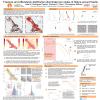Poster #159, Fault and Rupture Mechanics (FARM)
Modeling and observing supershear rupture: insufficient information from the presence of a daughter crack
Poster Image:

Poster Presentation
2020 SCEC Annual Meeting, Poster #159, SCEC Contribution #10711 VIEW PDF
isms that depend on the presence of heterogeneities like stress barriers, fault bends, and stepovers, and a mechanism that depends on wave conversions at the Earth’s free surface. Focusing on 3D dynamic models of the free-surface supershear mechanism, we discuss how different definitions of rupture velocity (and supershear rupture in particular) may lead to different classifications of ruptures as supershear or not. Much of the discrepancy hinges on whether a daughter crack ahead of the primary rupture front can be a reliable indicator of supershear rupture, and whether the apparent along-strike rupture velocity is truly indicative of large-scale supershear rupture. We discuss which definitions of supershear rupture are more consistent with the physical observables most commonly associated with supershear rupture, such as Mach cones and strong fault-parallel ground motion pulses that arrive before fault-normal pulses. The results may have implications for interpreting numerical models as well as observational evidence for supershear rupture.
SHOW MORE
SHOW MORE
























































